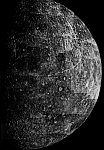Mercury
 Mercury is the closest planet to the Sun, and for this reason it
has a very short year. Its days are quite long, though, because the planet
revolves around its own axis very slowly. Due to both these factors, Mercury
has just one day for each two years. It was named after the Greek god
of commerce and travel, most likely because of its orbital velocity. The
planet has a high temperature range, varying between -180°C to 530°C,
and is the highest temperature range for any body in the Solar System.
Despite this, radar observations of Mercury have shown signs that water
and ice may be evident on some craters at the North Pole, which are shaded
from the Sun.
Mercury is the closest planet to the Sun, and for this reason it
has a very short year. Its days are quite long, though, because the planet
revolves around its own axis very slowly. Due to both these factors, Mercury
has just one day for each two years. It was named after the Greek god
of commerce and travel, most likely because of its orbital velocity. The
planet has a high temperature range, varying between -180°C to 530°C,
and is the highest temperature range for any body in the Solar System.
Despite this, radar observations of Mercury have shown signs that water
and ice may be evident on some craters at the North Pole, which are shaded
from the Sun.
|
Diameter |
4,880 km |
|
|
Mass |
3.3 × 1023 kg |
|
|
Mean Distance from sun |
57,910,000 km |
|
|
Mean Density |
5.43 g/cm3 |
|
|
Rotational Period |
59 Earth days |
|
|
Orbital Period |
88 Earth days |
|
|
Mean Orbital Velocity |
48 km/s |
|
|
Atmosphere |
50%
oxygen, 30% sodium, |
|
|
Average Surface Temperature |
179°C |
|
|
Equatorial Surface Gravity |
3.7 m/s2 |
|
| Copyright owned by the State of Victoria (Department of Education and Early Childhood Development). Used with Permission. |
|
|||||||||||||||||||||||||||||||||||||||||||||||||||||||||||||||||||||||||||||||||||||